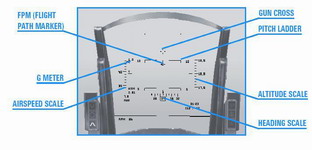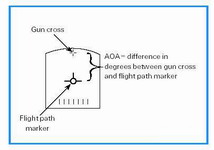
The HUD "Head-Up Display" From "Kofana"...
The flight path marker is the most useful part of the HUD. This symbol shows the pilot the flight path or vector that the
jet is on. If you use your joystick to place the flight path marker on a point over the ground and hold it there, the jet
will impact the ground on that exact spot. Hopefully, you won't be doing that too often, but the flight path marker can be
used in a very similar way to fly to a precise point on a runway. Just as importantly, the F-16 can be flown in level
flight or precise climbs and dives using the flight path marker.
The gun cross is the small cross symbol at the top of the HUD. It is an important reference since it represents the nose
of the aircraft. Keep in mind that the gun cross is not where the aircraft is pointing (although it is very close to where
the aircraft is pointing). The difference between the gun cross (the nose of the aircraft) and the flight path marker is
the AOA (Angle of Attack).

The pitch ladder provides a level flight reference along with a reference for climbs and descents. The long solid
horizontal line in the middle of the HUD is the 0o pitch line. It can be easily differentiated from the other
pitch ladder lines because it has no number associated with it. The dashed pitch ladder lines show descents in
5o increments while the solid lines show climbs.
The airspeed scale is on the left side of the HUD. Since this scale shows airspeed in increments of tens, "40"
means that you are going 400 knots (nautical miles per hour). The airspeed scale has a "C" next to the tick mark, which
stands for calibrated airspeed.
The altitude scale is on the right side of the HUD. This scale shows aircraft altitude in hundreds of feet above
sea level, also called MSL (Mean Sea Level). Remember, the HUD altitude scale shows altitude MSL-above sea level-and not
altitude above the ground (AGL). An altitude of "500" is 5,000 feet above sea level. When your penguin butt gets down
below 1,200 feet from the ground, the radar altimeter brings up a new altitude display in the HUD. Since this scale shows
hundreds of feet, when the sliding bar is next to "2," you are 200 feet above the ground. Keep in mind that this is the
ground directly underneath your jet and not the ground that is in front of you. As you climb and get above 1,500 feet, the
scale goes back to the normal sea level scale.

The heading scale at the bottom of the HUD shows aircraft heading. The scale simply shows aircraft heading in tens of
degrees. A heading of "27" would be 270o.
The HUD G meter in the top left corner of the HUD shows current G forces acting on the jet, whereas the G meter at the
bottom left corner of the HUD shows the maximum G force you have pulled so far during a given flight.

Click here for more pics related to HUD, cockpit, radar, dog-fight,
weapons, take-off, landing, etc...






